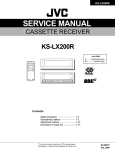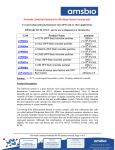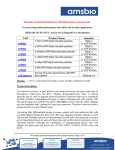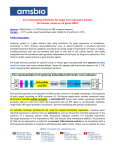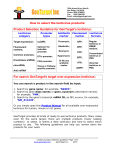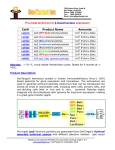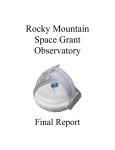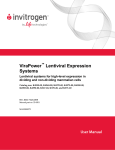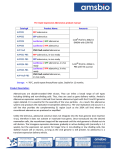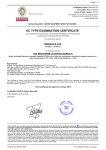Download Sample Data Sheet
Transcript
Pre-made tetracycline regulator (TetR) expression lentiviral particles user manual Cat# Product Name LVP017-Bsd-RFP CMV-TetR (Bsd-RFP) Lentiviral CMVparticles LVP017-Bsd CMV-TetR (Bsd) Lentiviral particles LVP017-Neo CMV-TetR (Neo) Lentiviral particles LVP017-Puro CMV-TetR (Puro) Lentiviral particles LVP017-Hygro CMV-TetR (Hygro) Lentiviral particles LVP459-GB EF1a-TetR (GFP-Bsd) Lentiviral particles LVP459-RB EF1a-TetR (RFP-Bsd) Lentiviral particles LVP459-RP EF1a-TetR (RFP-Puro) Lentiviral particles LVP459-Bsd EF1a-TetR (Bsd) Lentiviral particles LVP459-Neo EF1a-TetR (Neo) Lentiviral particles LVP459-Puro EF1a-TetR (Puro) Lentiviral particles LVP017-RB-PBS LVP017-Bsd-PBS LVP017-Neo-PBS LVP017-Puro-PBS LVP017-Hygro-PBS LVP459-GB-PBS LVP459-RB-PBS LVP459-RP-PBS LVP459-Bsd-PBS CMV-TetR (Bsd-RFP) Lentiviral particles in PBS CMV-TetR (Bsd) Lentiviral particles in PBS CMV-TetR (Neo) Lentiviral particles in PBS CMV-TetR (Puro) Lentiviral particles in PBS CMV-TetR (Hygro) Lentiviral particles in PBS EF1a-TetR (GFP-Bsd) Lentiviral particles in PBS EF1a-TetR (Bsd-RFP) Lentiviral particles in PBS EF1a-TetR (RFP-Puro) Lentiviral particles in PBS EF1a-TetR (Bsd) Lentiviral particles in PBS Amounts 200ul, (1 x 107 IFU/mL) in DMEM medium containing 10% FBS and 10x polybrene (60ug/ml) 200ul, (5 x 107 IFU/mL) in PBS LVP459-Neo-PBS LVP459-Puro-PBS EF1a-TetR (Neo) Lentiviral particles in PBS EF1a-TetR (Puro) Lentiviral particles in PBS Storage: <-70˚C, avoid repeat freeze/thaw cycles. Stable for >6 months at <-70˚C. Product Description: Lentiviral system is a gene delivery tool using lentivectors for gene expression or knockdown. Lentivectors are HIV-1 (Human Immunodeficiency Virus 1) derived plasmids, used to generate lentiviral particles (lentivirus) that can be transduced into almost all kinds of mammalian cell types or organs, including stem cells, primary cells and non-dividing cells both in vivo and in cell culture system. Particles can stably integrate into transduced cell’s genome for long term expression. Therefore, lentivirus holds unique promise as gene transfer agents. Pre-made tetracycline repressor (TetR) lentiviral particles are generated from re-engineered lentivector system. Sequence verified TetR gene is constitutively expressed under either our proprietary super CMV promoter (suCMV) or an enhanced EF1a promoter. The suCMV promoter provides highest TetR protein levels. The enhanced EF1a promoter is non-tissue specific promoter (active in almost all cell types) and is not silenced after long term cell culture. Amsbio provides the TetR expression particles with different antibiotic selection markers or fluorescent-antibiotic fusion dual markers under a separate RSV promoter. Please see the vector map schemes below for the expression lentivector core structure. VSV-G pseudotyped lentiviral particles are generated in 293T cell, and provided as 200ul/per tube in two solutions: (1) packaged in DMEM medium with 10% of FBS with 10x polybrene; or (2) re-suspended in PBS solution. The virus in PBS is used to transduce the cells that do not tolerate serum and polybrene in the culture medium. TetR is used in tetracycline inducible expression. It binds to any inducible promoters that have incorporated Tet binding sequence to repress target expression. Target expression is induced once tetracycline is added. The added tetracycline binds to TetR, which releases TetR from target's promoter, and starts the transcription. Amsbio’s lentiviral inducible expression vectors contain a strong constitutive promoter (CMV or H1) that integrated with two copies of tetracycline regulator binding sequences. This modification does not change promoter’s constitutive expression status. The GOI (gene of interest) can be expressed in high level as regular promoter without any induction. However, optionally, lentiviral particles can be turned into tetracycline inducible system by using TetR expressing particles. To achieve this inducible expression, the TetR protein has to be present to bind (block) the expression in advance. And the expression is induced after addition of tetracycline which removes the TetR from the promoter. See the illustration figure below about the inducible mechanism. Key features: 1. High level of TetR expression (driven by a super CMV promoter or an enhanced EF1a), with demonstrated minimal basal expression from inducible expression vectors or their expression particles; 2. Delivery of TetR expression lentivirus into dividing and non-dividing host mammalian cell lines via high virus titers; 3. Different antibiotic selection satisfies the requirement for different inducible expression vectors/ particles (i.e. the double antibiotic selection); 4. Depending on the cell lines and the TetR expression levels, normally a 20-fold to 1000-fold induction can be obtained after addition of tetracycline; Applications: The premade TetR lentiviral particle is the best method to deliver the TetR protein. Amsbio provides TetR expression lentiviral particles with different antibiotic markers. TetR expression particles can be used as follows: 1. They can be transduced alone into any host cell of your interest to generate TetR expression stable cell line. The generated stable cell line is then transduced with any inducible target expression particles, and the double transduced cells will demonstrate a tetracycline dose-dependent inducible expression of the target. 2. They can be co-transduced with any inducible target expression lentiviral particles. The double transduced cells (selected via two antibiotic markers) will demonstrate a tetracycline dose-dependent inducible expression of the target. Protocols (as a general reference): Method A: transduce TetR lentiviral particles alone to generate TetR-stable cell line: 1. Plate cells in 0.5 ml of complete medium into each well of 24-well plate, incubate at 37˚C overnight. 2. At the time of transduction, the cell density should be around 50% confluent. Thaw TetR lentiviral particle, add 20ul - 100ul into one well depending on cell types (Note: actively dividing cells have higher transduction efficiency, therefore, less virus is needed). Optionally, add polybrene into medium at final concentration of 6ug/ml (Note: polybrene can enhance transduction efficiency, but it may be toxic to some cell lines, like some primary neuron cells), incubate cells at 37˚C for 72 hours, 3. Remove the medium and replace with fresh, complete medium containing the appropriate amount of antibiotic (depending on TetR particle types) to select for stably transduced cells; 4. Trypsinize cells and pass into new well in 24-well plate in complete medium with appropriate amount of antibiotic (Note: a kill curve may have to be tested first to determine the minimal concentration of the appropriate antibiotic that is required to kill your untransduced cells), and replace medium containing antibiotic every 2-3 days until resistant colonies can be identified (Note: it takes 2-5 weeks depending on antibiotic type). 5. Pick several resistant colonies and expand each clone into flask and assay for Tet repressor expression by ELISA or qRT-PCR (Note: TetR assay materials need to be obtained and is not provided with TetR particles). Alternatively, you may pool the heterogeneous population of resistant cells and assay for Tet repressor expression. If Bsd-RFP dual marker TetR particles (Cat#: LVP017-Bsd-RFP) are used, the TetR expression cells can be identified via RFP fluorescence under microscope. 6. Positive transduced cells are ready for transfection with inducible expression vectors or transduction with inducible expression lentiviral particles, for the tetracycline inducible expression. 7. At 48 hours after delivery target expression vector/particles, change medium and add tetracycline to induce expression of the target. (Note: vary the final concentration of tetracycline from 0.01 ug/ml to 1 ug/ml to obtain different expression levels of target). Method B: co-transduce TetR lentiviral particles and expression particles for tetracycline inducible expression: 1. Plate cells in 0.5 ml of complete medium each well in 24-well plate, incubated at 37˚C for overnight, 2. At the time of transduction, the cell density should be around 50% confluency. Thaw TetR lentiviral particles, add 50ul - 100ul of TetR particles into one well, depending on cell type (Note: active dividing cells have higher transduction efficiency, therefore, less virus is needed). Optionally, add polybrene into medium at final concentration of 6ug/ml (Note: polybrene can enhance transduction efficiency, but may be toxic to some cell lines, like some primary neuron cells), incubate cells at 37˚C for 24 hours, 3. Then, add ~50ul of inducible expression particles into the well of 24-well plates (Note: ideally, the TetR particles/ expression particles MOI ratio should be 5:1, but in general, you should use more TetR particles than expression particles), incubate at 37˚C for overnight, 4. Add tetracycline to induce expression. The amount of tetracycline to use is dependent on cell type, a common used final concentration is 1ug/ml. (Note: many bovine sera used in culture are contaminated with tetracycline or its derivatives, which can affect basal expression), 5. Alternatively, at 48-72 hours after both transductions, add antibiotics to select for stably transduced cells (Note: add both antibiotics for TetR particles and expression particles at the same time to select double transduced cells). 6. After obtaining the double transduced cells, add tetracycline to induce expression of the gene of interest. (Note: vary the concentration of tetracycline from 0.1 ug/ml to 2 ug/ml to obtain different expression levels of target). Example / Control for inducible expression: The following picture demonstrated the GFP expression from premade inducible GFP lentiviral particles (Cat#: LVP024) before and after induction. Related products: Products Name Product series Premade expression ready (>500 CAT#) lentiviral particle for human and mouse genes Inducible expression control viruses TetR expression stable cell lines Applications Used for constitutive expression of human or mouse targets. Used with TetR particles together for inducible expression of a human or mouse target. GFP (CAT#:LVP024) Control GFP, RFP or YFP lentiviral YFP (CAT#: LVP357) particles for validation of inducible RFP (CAT#: LVP531) expression. Premade TetR Stable cell lines Used for tetracycline inducible in HEK293 cells with different expression of any constructs with TetR antibiotic selection markers binding sequence in their promoter. (CAT#: SC005) . Safety Precaution: Lentiviral particles have adopted the most advanced lentiviral safety features (using the third generation vectors with self-inactivation SIN-3’UTR), and the premade lentivirus is replication incompetent. However, please use extra caution when using lentiviral particles. Use the lentiviral particles in Bio-safety II cabinet. Ware gloves at all times, when handling Lentiviral particles! Please refer to CDC and NIH’s guidelines for more details regarding the safety issues. References: 1. 2. 3. 4. Annu Rev Microbiol. 1994;48:345-69 Microbiol Mol Biol Rev. 2005 Jun;69(2):326-56 NIH Guidelines for Biosafety Considerations for Research with Lentiviral Vectors link CDC guidelines for Lab Biosafety levels link









